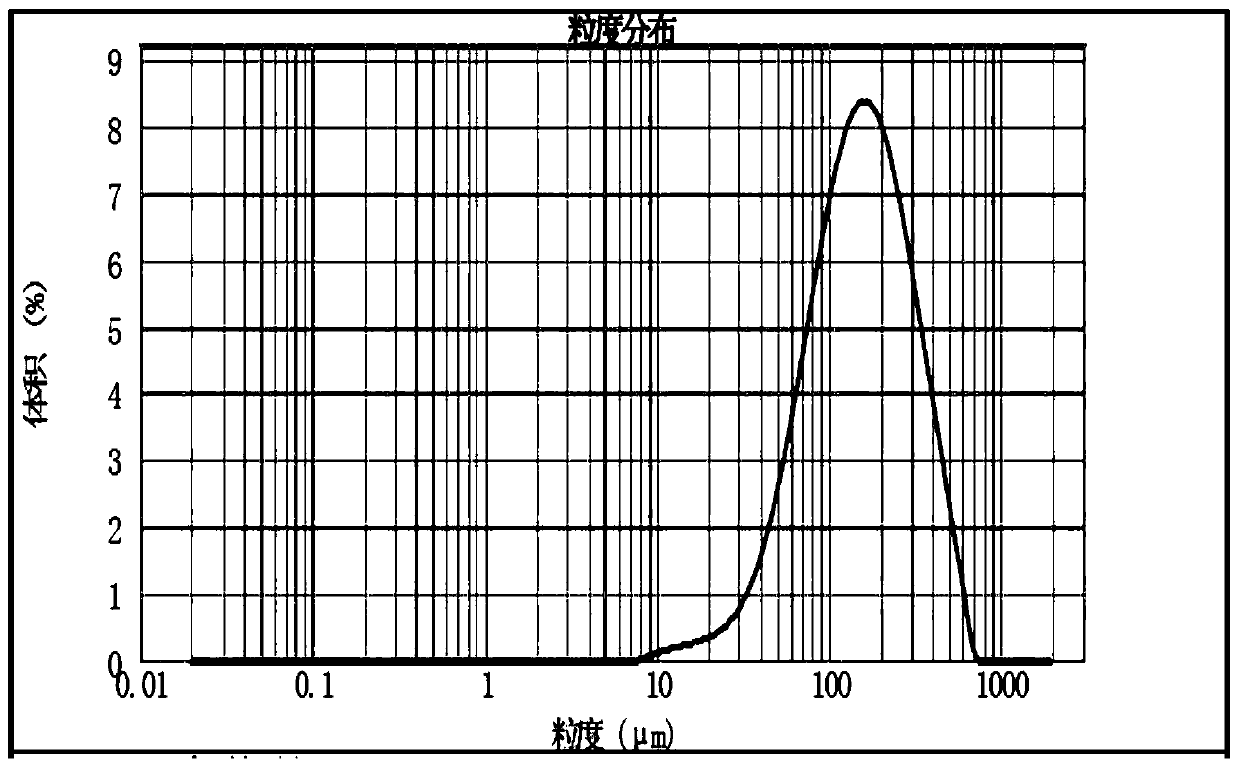A kind of preparation method of hydrophilic acrylamide-based cross-linked polymer microspheres
An acrylamide-based, cross-linked polymer technology, which is applied in the direction of drilling compositions, chemical instruments and methods, can solve the problems of wide distribution and large particle size of polymer microspheres, and achieve low cost and low viscosity of the system , The effect of environmental protection in the reaction process
- Summary
- Abstract
- Description
- Claims
- Application Information
AI Technical Summary
Problems solved by technology
Method used
Image
Examples
Embodiment 1
[0023] Step 1: Add 80 parts of methacryloxyethyl trimethylammonium chloride to 70 parts of distilled water, stir well, and then add 0.01 parts of 2,2-azo (2-methylpropyl amidine) Stir the dihydrochloride evenly, then heat the water bath to 50-60℃ for 6-7h while blowing nitrogen for 30-40 minutes;
[0024] Step 2: Take out the reaction product of step 1, wash it with ethanol 3 times, add acetone to dilute it, then put it in an oven at 50-55℃ for 24 hours, dry and pulverize to obtain polymethacryloxyethyl triacetate Methyl ammonium chloride is ready for use;
[0025] Step 3: Take 18 parts of ammonium sulfate and add to 45 parts of distilled water, fully stir and dissolve to obtain an ammonium sulfate solution;
[0026] Step 4: Add 1.5 parts of acrylamide, 2 parts of methacryloyloxyethyl trimethylammonium chloride, 1 part of acrylic acid, 0.02 parts of 2,2-azo(2-methylpropane Amidine) dihydrochloride, co-crosslinking agent, and dispersant are added to the ammonium sulfate solution in ...
Embodiment 2
[0029] Step 1: Add 85 parts of methacryloxyethyl trimethylammonium chloride to 75 parts of distilled water, stir well, and then add 0.05 parts of 2,2-azo (2-methylpropyl amidine) Stir the dihydrochloride evenly, then heat the water bath to 50-60℃ for 6-7h while blowing nitrogen for 30-40 minutes;
[0030] Step 2: Take out the reaction product of step 1, wash it with ethanol 3 times, add acetone to dilute it, then put it in an oven at 50-55℃ for 24 hours, dry and pulverize to obtain polymethacryloxyethyl triacetate Methyl ammonium chloride is ready for use;
[0031] Step 3: Add 20 parts of ammonium sulfate to 50 parts of distilled water, fully stir and dissolve to obtain an ammonium sulfate solution;
[0032] Step 4: Add 2.0 parts of acrylamide, 2.5 parts of methacryloyloxyethyl trimethylammonium chloride, 1.8 parts of acrylic acid, 0.03 parts of 2,2-azo(2-methylpropane Amidine) dihydrochloride, co-crosslinking agent, and dispersant are added to the ammonium sulfate solution in step...
Embodiment 3
[0035] Step 1: Add 90 parts of methacryloxyethyl trimethyl ammonium chloride to 80 parts of distilled water, stir well, and then add 0.1 part of 2,2-azo (2-methylpropyl amidine) Stir the dihydrochloride evenly, then heat the water bath to 50-60℃ for 6-7h while blowing nitrogen for 30-40 minutes;
[0036] Step 2: Take out the reaction product of step 1, wash it with ethanol 3 times, add acetone to dilute it, then put it in an oven at 50-55℃ for 24 hours, dry and pulverize to obtain polymethacryloxyethyl triacetate Methyl ammonium chloride is ready for use;
[0037] Step 3: Take 22 parts of ammonium sulfate and add it to 55 parts of distilled water, fully stir and dissolve to obtain an ammonium sulfate solution;
[0038] Step 4: Add 2.5 parts of acrylamide, 3 parts of methacryloyloxyethyl trimethylammonium chloride, 2.5 parts of acrylic acid, 0.04 parts of 2,2-azo (2-methylpropane Amidine) dihydrochloride, co-crosslinking agent, and dispersant are added to the ammonium sulfate soluti...
PUM
| Property | Measurement | Unit |
|---|---|---|
| particle diameter | aaaaa | aaaaa |
Abstract
Description
Claims
Application Information
 Login to View More
Login to View More - R&D
- Intellectual Property
- Life Sciences
- Materials
- Tech Scout
- Unparalleled Data Quality
- Higher Quality Content
- 60% Fewer Hallucinations
Browse by: Latest US Patents, China's latest patents, Technical Efficacy Thesaurus, Application Domain, Technology Topic, Popular Technical Reports.
© 2025 PatSnap. All rights reserved.Legal|Privacy policy|Modern Slavery Act Transparency Statement|Sitemap|About US| Contact US: help@patsnap.com



